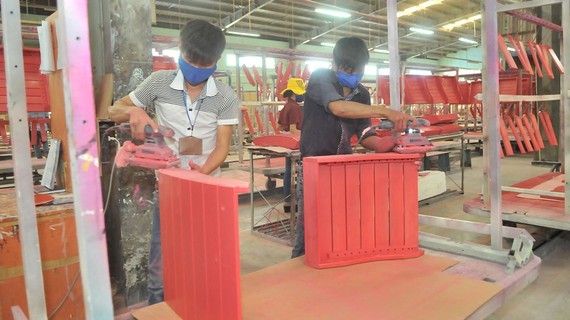
According to the General Department of Vietnam Customs, in the first two months of this year, wood and wooden product export turnover of Vietnam nearly reached US$1.6 billion, an increase of 18 percent over the same period last year. However, in the first half of March, wood and wooden product exports dropped to $447 million. The export turnover and growth rate of the industry are expected to decline more sharply seriously in the future when the disease is increasing seriously and developing complicatedly in key export markets.
Mr. Dien Quang Hiep, CEO of Minh Phat Co., Ltd., said that most of the wooden products of his company were exported to the US market. However, recently, its partners notified that they would have to delay import orders to May or June. A quick survey on 124 large wood processing enterprises showed that more than 51 percent of enterprises have reduced their production scale. 35 percent of enterprises though are still operating normally, will have to temporarily halt operations shortly. Only 7 percent of enterprises are still operating normally but they cannot be sure because the pandemic remains complicated.
In fact, since mid-March this year, the pandemic broke out heavily in major import markets of Vietnamese wooden products, including the US which accounted for 50 percent of total export value, Europe which accounted for 10 percent, and Japan which accounted for 13 percent. These governments are applying many strong policies to control the spread of the pandemic, such as border closures and closure of all non-essential chain stores. This has led to serious disruption in the global supply chain with many deals were delayed or canceled.
Currently, enterprises in the industry have continuously received notifications from their partners about extending delivery time, canceling delivery, even for batches of products that were produced or are in the process of production. They were also informed that some large customers were about to go bankrupt. Particularly in China, the third-largest market of Vietnam with 12 percent of the total annual export turnover, although the disease has been controlled, it would take lots of time to restore the purchasing power to the same as before the pandemic happened.
Results of a quick survey on 124 enterprises of the Vietnam Timber and Forest Product Association (Vifores) showed that up to 75 percent of enterprises have reported initial losses estimated at VND3.06 trillion. 24 percent of enterprises participating in the survey have not determined their losses. About 1 percent of enterprises said that the Covid-19 pandemic made their revenues reduce by 70 percent.
To cope with the above situation, many enterprises also cut their employment by about 45 percent. For example, among 105 enterprises providing information on labor, before the Covid-19 pandemic, the total number of employees working in these enterprises was 47,506 but so far, 21,410 workers have been laid off. According to economic experts, wood and wooden product manufacturing enterprises must take into account the factor of increasing domestic market share. However, according to many businesses, it is not easy.
Representatives of Vifores, the Handicraft and Wood Industry Association of Ho Chi Minh City (Hawa), and the Forest Products Association of Binh Dinh Province said that there are about 5,000 enterprises producing wood and wood products nationwide. In particular, 3,000 enterprises are specializing in manufacturing products for export market share. The rest mainly supplies the domestic market. However, with only 2,000 manufacturing enterprises supplying the domestic market, it is difficult to increase the market share due to the limited market size. The domestic market is also mainly concentrated in big cities like Hanoi, Ho Chi Minh City, Binh Duong, and Dong Nai provinces.
However, in the context of the current pandemic, consumers are tightening spending, in addition, real estate projects are at risk of freezing, causing the production scale of timber enterprises to decline sharply. So, getting into the domestic market is more and more difficult, it needs a certain roadmap because each market has different requirements on the style, shape, and quality of products. Therefore, in a short time, it is impossible for enterprises to change.
Amid the current difficult situation, many enterprises said that the Government, as well as competent authorities, should consider implementing many synchronous solutions to help enterprises to maintain production. The representative of Hawa emphasized that for laid-off workers, the Government should provide a subsidy of one month’s salary for each worker according to regulations of the Labor Law. The estimated total funding for the industry is around VND146.7 billion. As for enterprises, it is necessary to reduce taxes and fees, including corporate income tax, value-added tax, social insurance, and land rent.
The Government also needs to have more drastic guidelines for the commercial banking system to extend loans, reducing bank interest rates to 2 percent - 5 percent. In addition, some businesses also proposed the Government to suspend the payment of value-added tax on imported raw materials.
Mr. Dien Quang Hiep, CEO of Minh Phat Co., Ltd., said that most of the wooden products of his company were exported to the US market. However, recently, its partners notified that they would have to delay import orders to May or June. A quick survey on 124 large wood processing enterprises showed that more than 51 percent of enterprises have reduced their production scale. 35 percent of enterprises though are still operating normally, will have to temporarily halt operations shortly. Only 7 percent of enterprises are still operating normally but they cannot be sure because the pandemic remains complicated.
In fact, since mid-March this year, the pandemic broke out heavily in major import markets of Vietnamese wooden products, including the US which accounted for 50 percent of total export value, Europe which accounted for 10 percent, and Japan which accounted for 13 percent. These governments are applying many strong policies to control the spread of the pandemic, such as border closures and closure of all non-essential chain stores. This has led to serious disruption in the global supply chain with many deals were delayed or canceled.
Currently, enterprises in the industry have continuously received notifications from their partners about extending delivery time, canceling delivery, even for batches of products that were produced or are in the process of production. They were also informed that some large customers were about to go bankrupt. Particularly in China, the third-largest market of Vietnam with 12 percent of the total annual export turnover, although the disease has been controlled, it would take lots of time to restore the purchasing power to the same as before the pandemic happened.
Results of a quick survey on 124 enterprises of the Vietnam Timber and Forest Product Association (Vifores) showed that up to 75 percent of enterprises have reported initial losses estimated at VND3.06 trillion. 24 percent of enterprises participating in the survey have not determined their losses. About 1 percent of enterprises said that the Covid-19 pandemic made their revenues reduce by 70 percent.
To cope with the above situation, many enterprises also cut their employment by about 45 percent. For example, among 105 enterprises providing information on labor, before the Covid-19 pandemic, the total number of employees working in these enterprises was 47,506 but so far, 21,410 workers have been laid off. According to economic experts, wood and wooden product manufacturing enterprises must take into account the factor of increasing domestic market share. However, according to many businesses, it is not easy.
Representatives of Vifores, the Handicraft and Wood Industry Association of Ho Chi Minh City (Hawa), and the Forest Products Association of Binh Dinh Province said that there are about 5,000 enterprises producing wood and wood products nationwide. In particular, 3,000 enterprises are specializing in manufacturing products for export market share. The rest mainly supplies the domestic market. However, with only 2,000 manufacturing enterprises supplying the domestic market, it is difficult to increase the market share due to the limited market size. The domestic market is also mainly concentrated in big cities like Hanoi, Ho Chi Minh City, Binh Duong, and Dong Nai provinces.
However, in the context of the current pandemic, consumers are tightening spending, in addition, real estate projects are at risk of freezing, causing the production scale of timber enterprises to decline sharply. So, getting into the domestic market is more and more difficult, it needs a certain roadmap because each market has different requirements on the style, shape, and quality of products. Therefore, in a short time, it is impossible for enterprises to change.
Amid the current difficult situation, many enterprises said that the Government, as well as competent authorities, should consider implementing many synchronous solutions to help enterprises to maintain production. The representative of Hawa emphasized that for laid-off workers, the Government should provide a subsidy of one month’s salary for each worker according to regulations of the Labor Law. The estimated total funding for the industry is around VND146.7 billion. As for enterprises, it is necessary to reduce taxes and fees, including corporate income tax, value-added tax, social insurance, and land rent.
The Government also needs to have more drastic guidelines for the commercial banking system to extend loans, reducing bank interest rates to 2 percent - 5 percent. In addition, some businesses also proposed the Government to suspend the payment of value-added tax on imported raw materials.
























